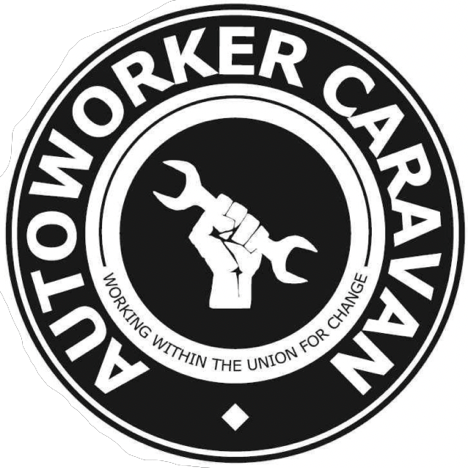
THE UNION HERO THAT UAW LEADERS WON’T TELL YOU ABOUT
Commemorating International Working Women’s Day (3/8) and Women’s History Month
Article and photos (unless otherwise noted) by Frank Hammer
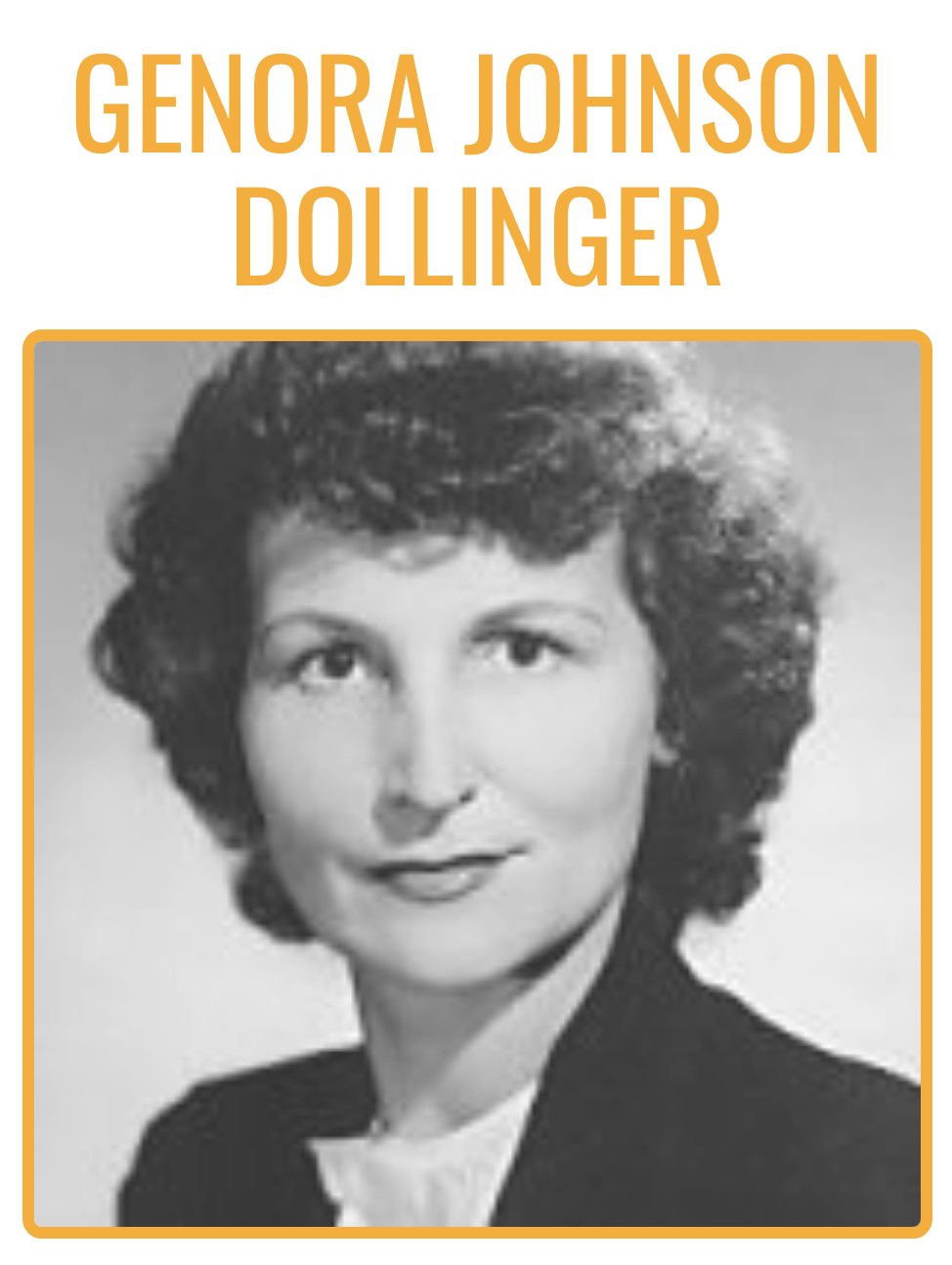
The graphic pasted here is from a UAW webpage featuring 8 important women in the UAW. Clicking on any of the images takes you to their respective biographies. Curiously, that’s not true for Genora Johnson Dollinger. Click on this link and see for yourself. While the link describes activities in the 30s that she organized and led, her name or information about her is absent.
General Motors would never have agreed to recognize the UAW on February 11, 1937 as its workers’ sole bargaining agent were it not for the heroism and brilliance of Genora Johnson Dollinger. At the age of 23, Genora was the founder and principal leader of the militant Women’s Emergency Brigade (WEB). Without her and her 300+ sisters willing to tangle with GM’s hired Pinkerton strikebreakers, GM’s private police, and the GM-controlled Flint police, the successful outcome of the 44-day occupation of GM’s factories by Flint’s autoworkers would have been in doubt. In her 1995 obituary (see below) she’s described as the “Joan of Arc” of labor. Why, then, does the UAW’s website not honor her?
The reasons will become clear as I take you through some of my photos and clippings which lend insight into her contributions to our Union, and why the current political caucus in power — the Administration Caucus — would prefer to keep Genora anonymous. Her memory will hopefully be restored to its rightful place out of the UAW that will emerge with new leadership later this year, made possible by the victory of the “One Member, One Vote” referendum advocated by Unite All Workers for Democracy UAWD.
From her Obituary
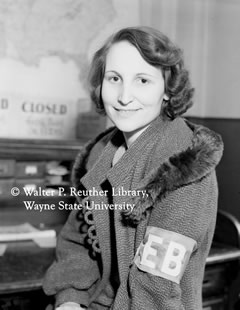
Genora’s life spanned 82 years — 1913-1995. At age 18, she became a charter member of the Flint Socialist Party which, “was later to have a preeminent role in the leadership of the sitdown strikes.” She and her husband, Kermit Johnson, are credited with advancing the “greatest strike strategy in the history of American labor,” overcoming Walter Reuther’s resistance in the process. She took a job in Detroit after being blacklisted in Flint, and was elected to a leadership position at a Briggs UAW Local. While investigating beatings of prominent local union leaders, she herself was beaten with a lead pipe in her sleep, “instigated by well known Detroit Corporate officials in collusion with the Mafia.” She was hospitalized for 6 weeks.
As a leader in the American Civil Liberties Union, Genora excelled in leading civil rights causes. As one of the first presidents of Women for Peace in the 60s, she took on the leaders of the AFL-CIO and UAW in her opposition to the Vietnam War.
She was invited in 1977 (the obituary incorrectly says 1945) to a joint (!) GM-UAW 40th anniversary celebration of the Flint Sit-down at the Regis Hotel in Detroit. She flew in from California only to “denounce the union leaders for their participation in the love fest as an example of ‘Tuxedo Unionism.’”
Genora is of the great tradition of Mother Jones who in an earlier generation was to the Mine Workers what Genora became to Auto Workers. A living legend in her own time. Genora was one of the foremothers of the Women’s Liberation Movement.
The obituary
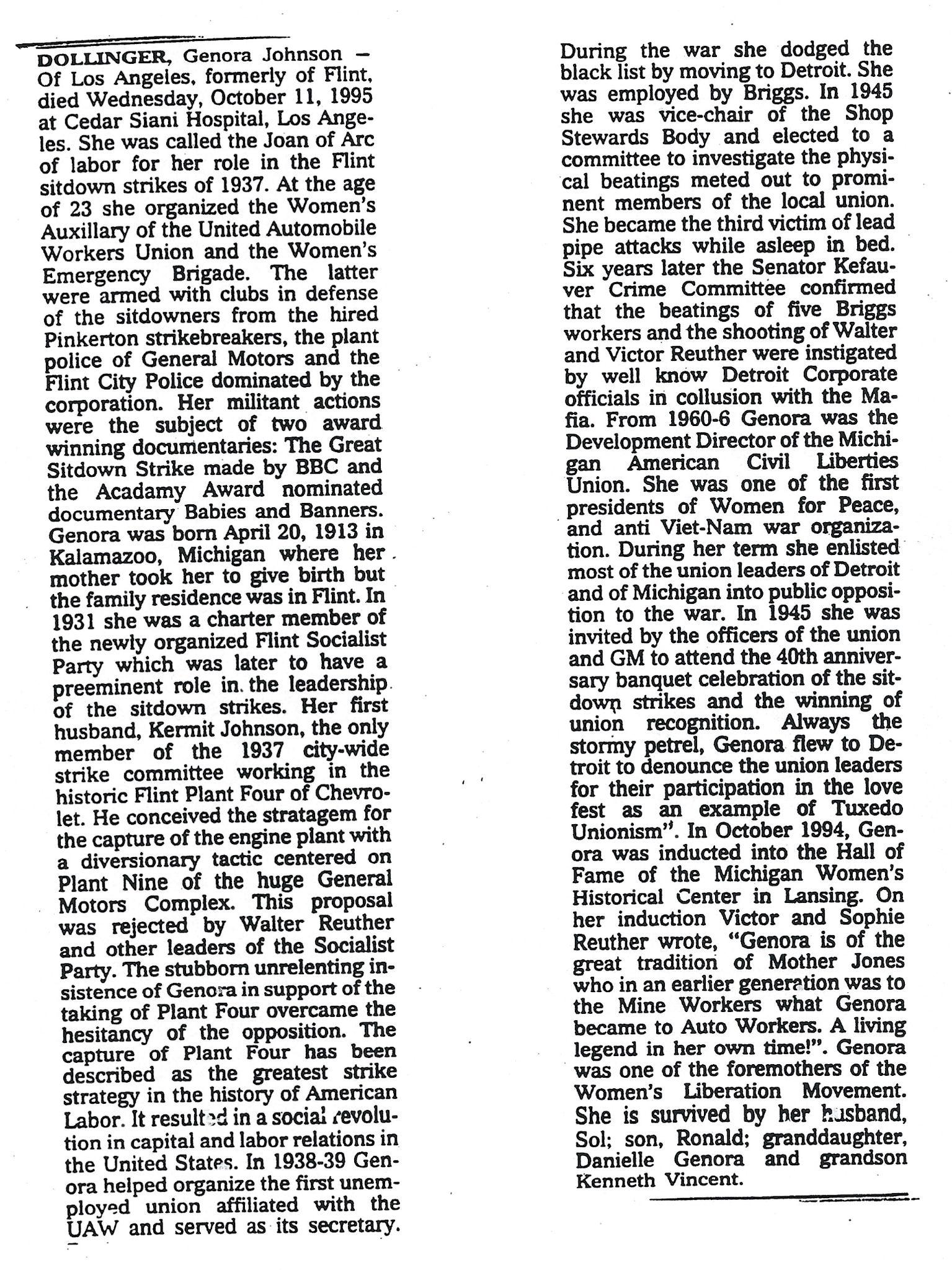
Genora’s militant actions were the subject of two award winning documentaries, The Great Sit-Down — Yesterday’s Witness in America and With Babies and Banners: Story of the Women’s Emergency Brigade (1979).
“Tuxedo Unionism”
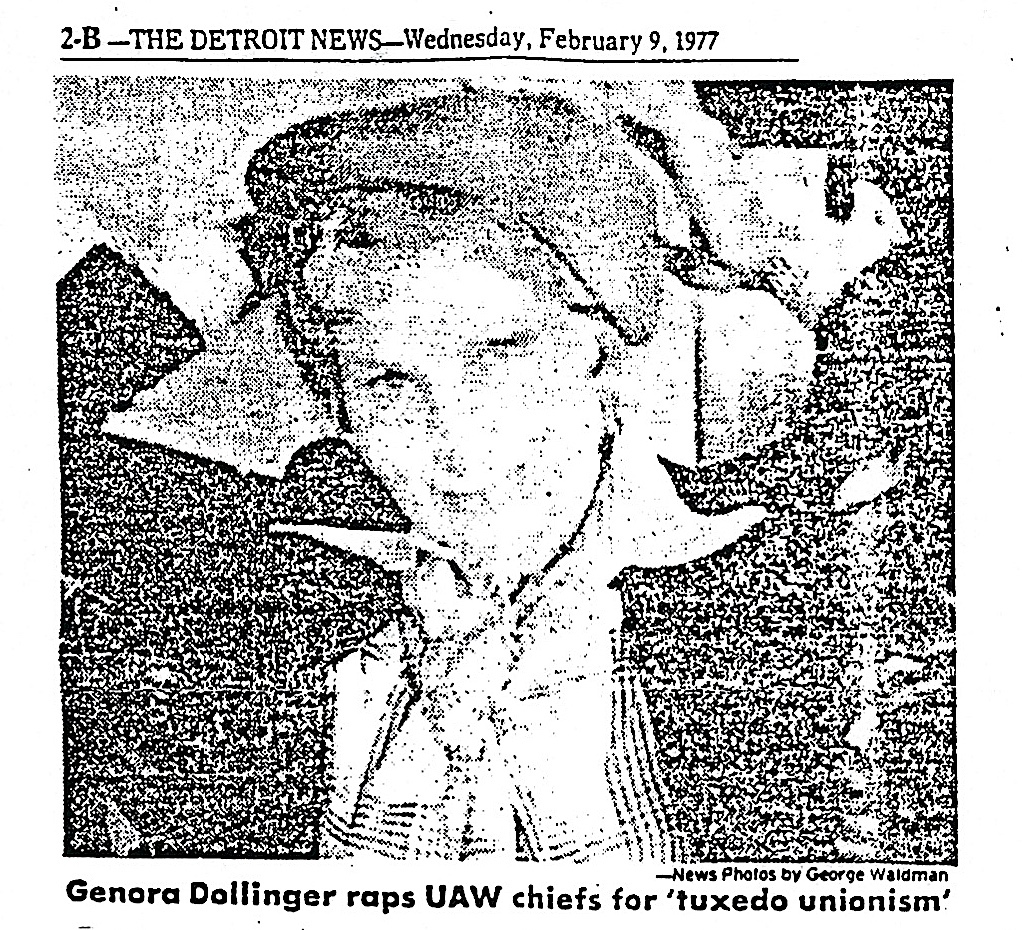
Genora’s outspoken response to the 1977 GM-UAW “banquet celebration” mentioned in the 2nd column of her obituary caught the attention of the Detroit News (Feb 9, 1977):
I cannot in good conscience take part in a celebration under the hegemony of the very corporation which has fought us at every step down to the present day where new GM plants are reopened in the South with nonunion labor.
The paper went on to say:
Mrs. Dollinger acidly questioned why union officials like Woodcock and Bluestone needed ‘GM’s good housekeeping seal of approval on organizing drives. In only 40 years we witness a return to tuxedo unionism…
She added:
While each of us marches to the beat of a different drum, the beat of my march must remain with those men and women who are in the factories, making the profits and providing the very sustenance of our rich country.
According to the News, the UAW’s Public Relations Director said:
Union officials would have no comment on Mrs. Dollinger’s blast.
The full article

That following June, she and other Brigade members — as documented in the film “With Babies and Banners” — crashed the UAW’s 25th Convention, praising the role of the Women’s Emergency Brigade and chanting, “the UAW needs an ERA!” They had to let Genora speak.
For the UAW’s 1986 commemoration of “White Shirt” Day, Dollinger published two articles in the Sit-Down Edition of Flint UAW Local 599’s newspaper, Searchlight (February 6, 1986). In the first, “The Head Fixing Industry And the 30-Hour Week,” she challenges the UAW, asking,
Why aren’t we talking about the 30-hour week with 40 hours pay as advocated by UAW leaders and Convention delegates from the beginning of our Union?
Focusing on job elimination through increased automation, Genora stated,
When Labor supports policies that lead to its own destruction we know the Headfixers have been successful in their indoctrinations…
In response to that economic depression [in the 1930s] the UAW, at its first conventions, passed resolutions proclaiming our belief in the 30-hr week at 40-hours pay. This is part of our history. IN THE PRESENT CRISIS OUR OWN UNION IS SILENT. It’s a prime example of the Headfixers at work.
There is an avalanche of corporations forcing the adoption of the two-tier wage system — another example of how industry divides workers. The Headfixers insist it is necessary in order to compete with cheap labor abroad…IT IS TIME TO REVERSE LABOR’S RETREAT AND RETURN TO THE MILITANT TACTICS OF 1937.
The complete article
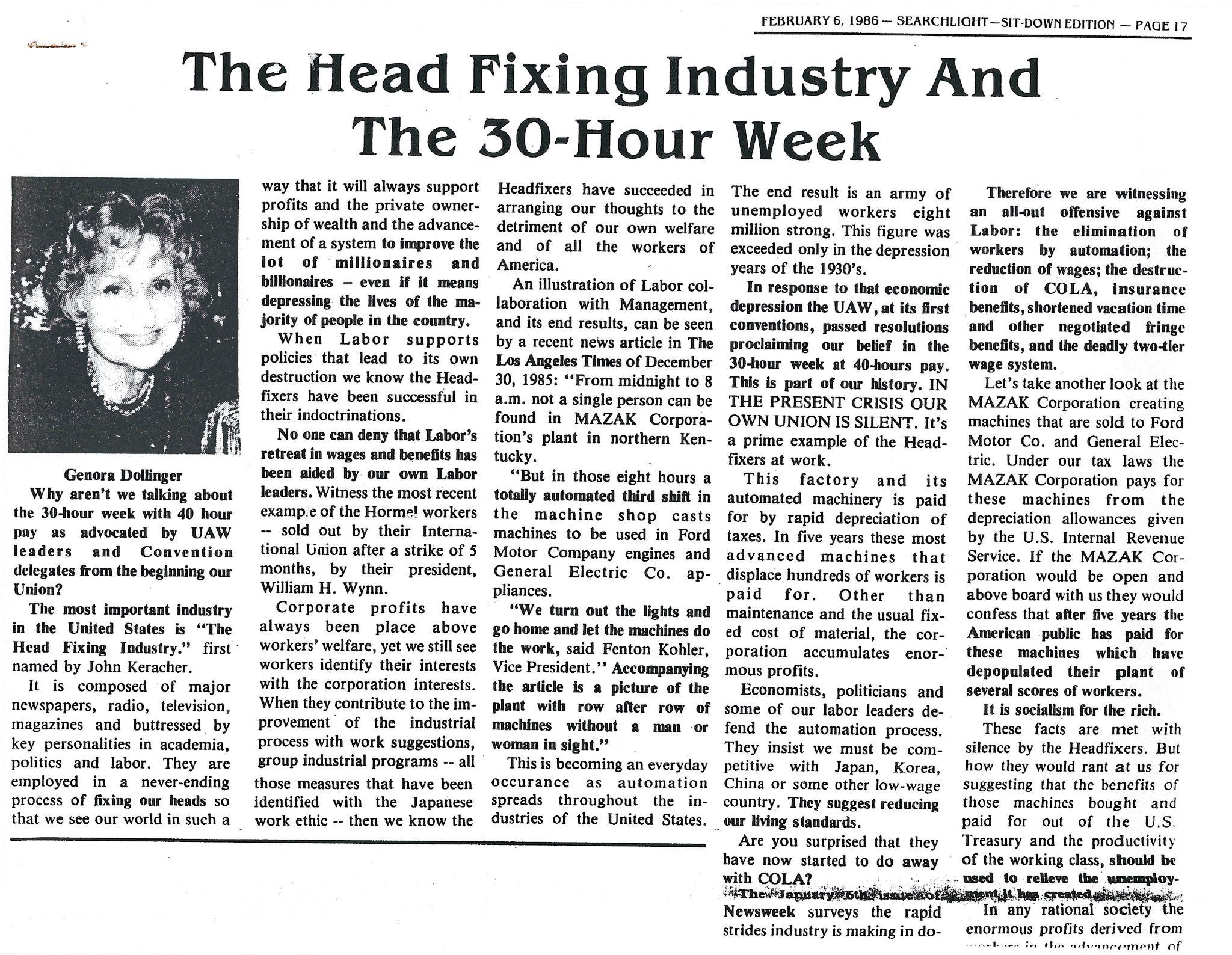
The article continues below: (missing a few lines, unfortunately).

In the article “Hail to the Red Berets…” she writes:
One of the proudest and best memories 0f 1985 was the valiant younger UAW women honoring the courageous women of the Women’s Emergency Brigade of the great GM Sitdown Strike of 1937. This was done in a public demonstration of solidarity in the highly-touted 50th Anniversary Celebration last August…That is why it was such a bright spot…to hear about the UAW women of today insisting upon the historic role played by their foremothers in establishing the UAW.
Full article below (minus a line or two):

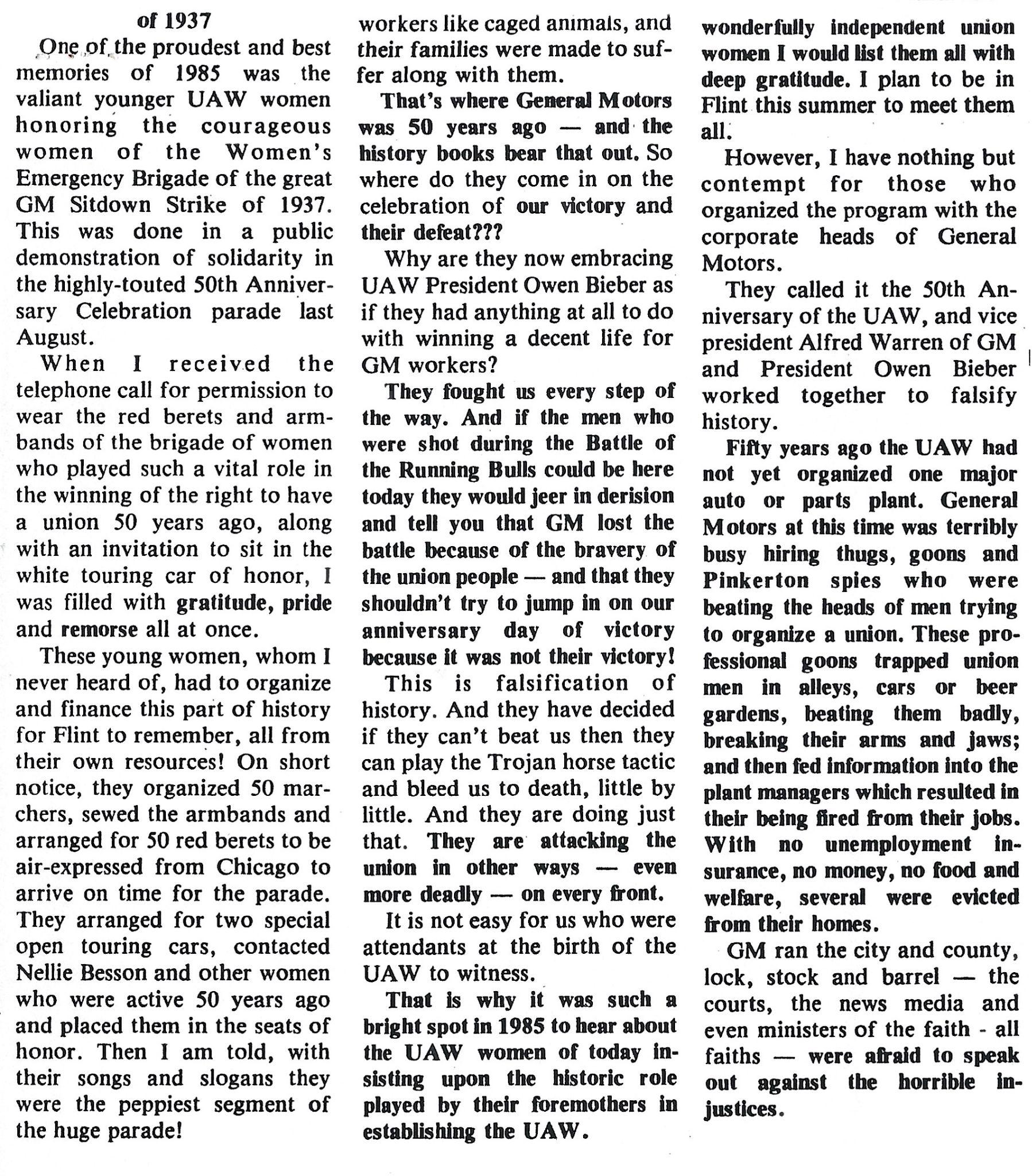
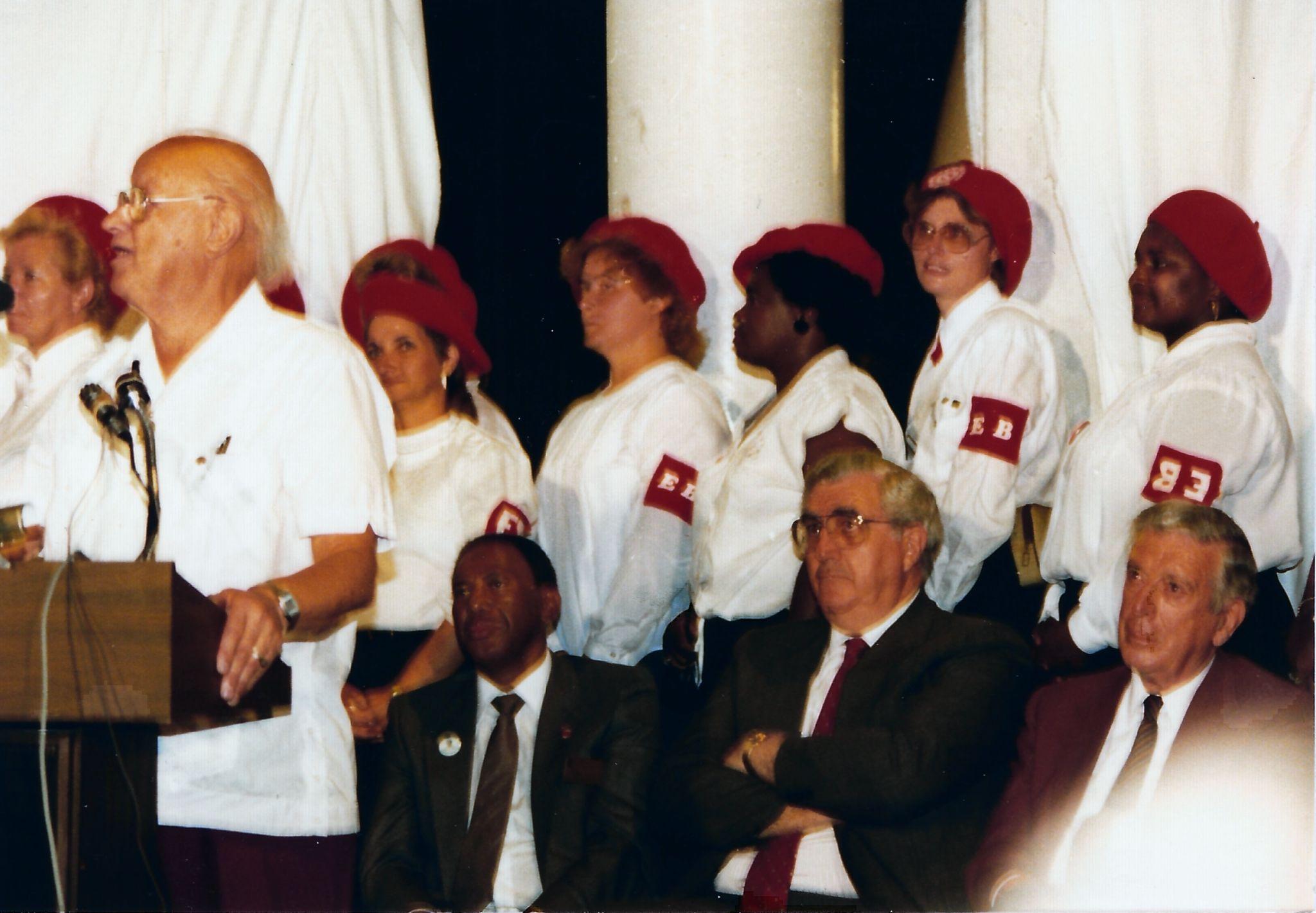
Women of the “Red Berets,” 1987 Flint 50th Anniversary Parade, with Victor Reuther. Seated, Left to Right — Reuben Burke (?), Owen Bieber, Leonard Woodcock. Standing behind Woodcock is Fran Cleaves, deceased mom of Mateen Cleaves, All-American MSU basketball player.
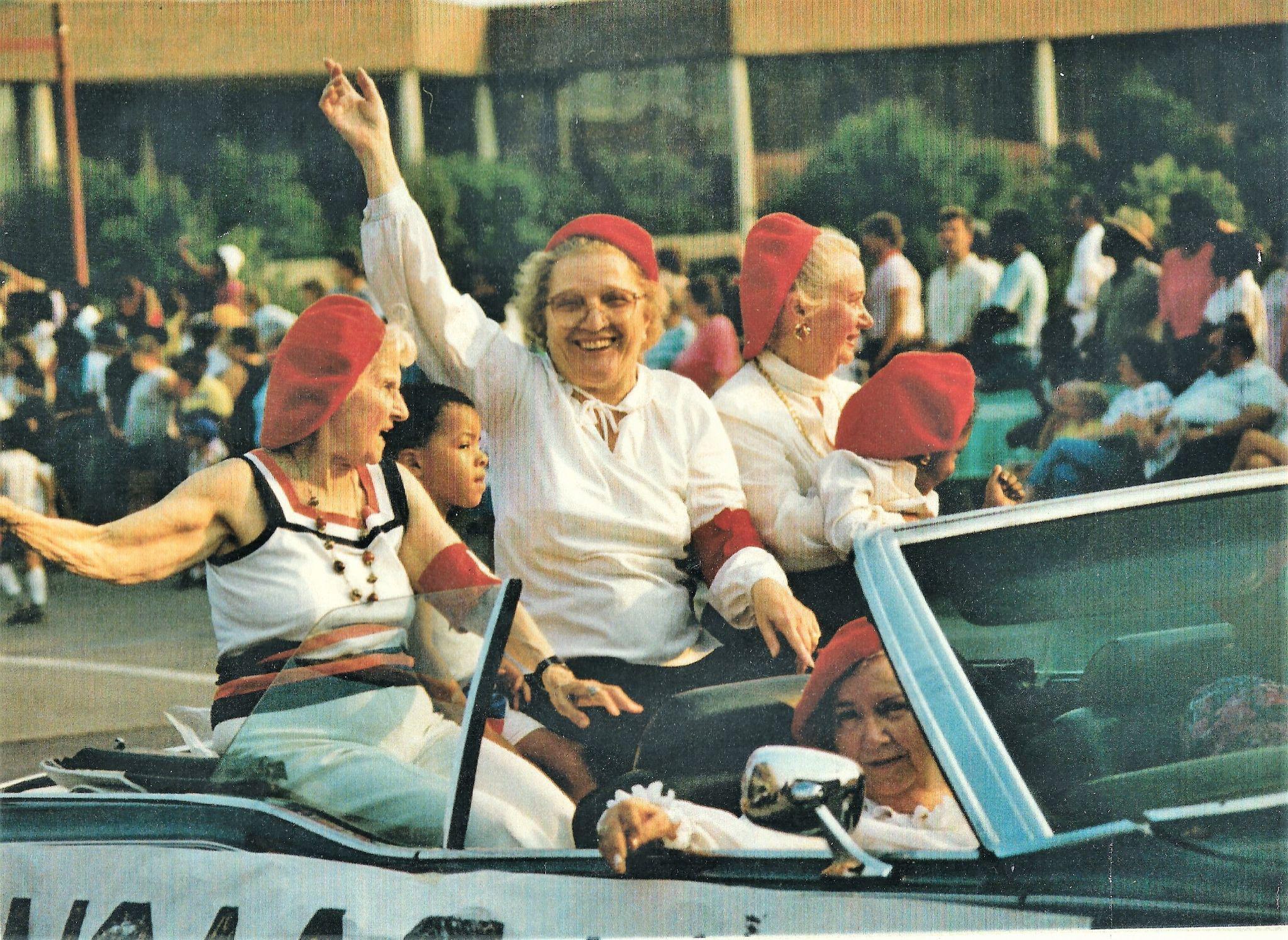
Left to right — Genora Johnson Dollinger, Nellie Hendrix Simons, and Geraldine Blankinship. 1987 Flint MI motorcade to honoring Sit-downers and the Women’s Emergency Brigade.
Not surprisingly, Genora — along with Victor Reuther — joined with the “New Directions” reform movement led by Region 5 Director, Jerry Tucker, at the 29th UAW Constitutional Convention, June, 1989, Anaheim, CA.
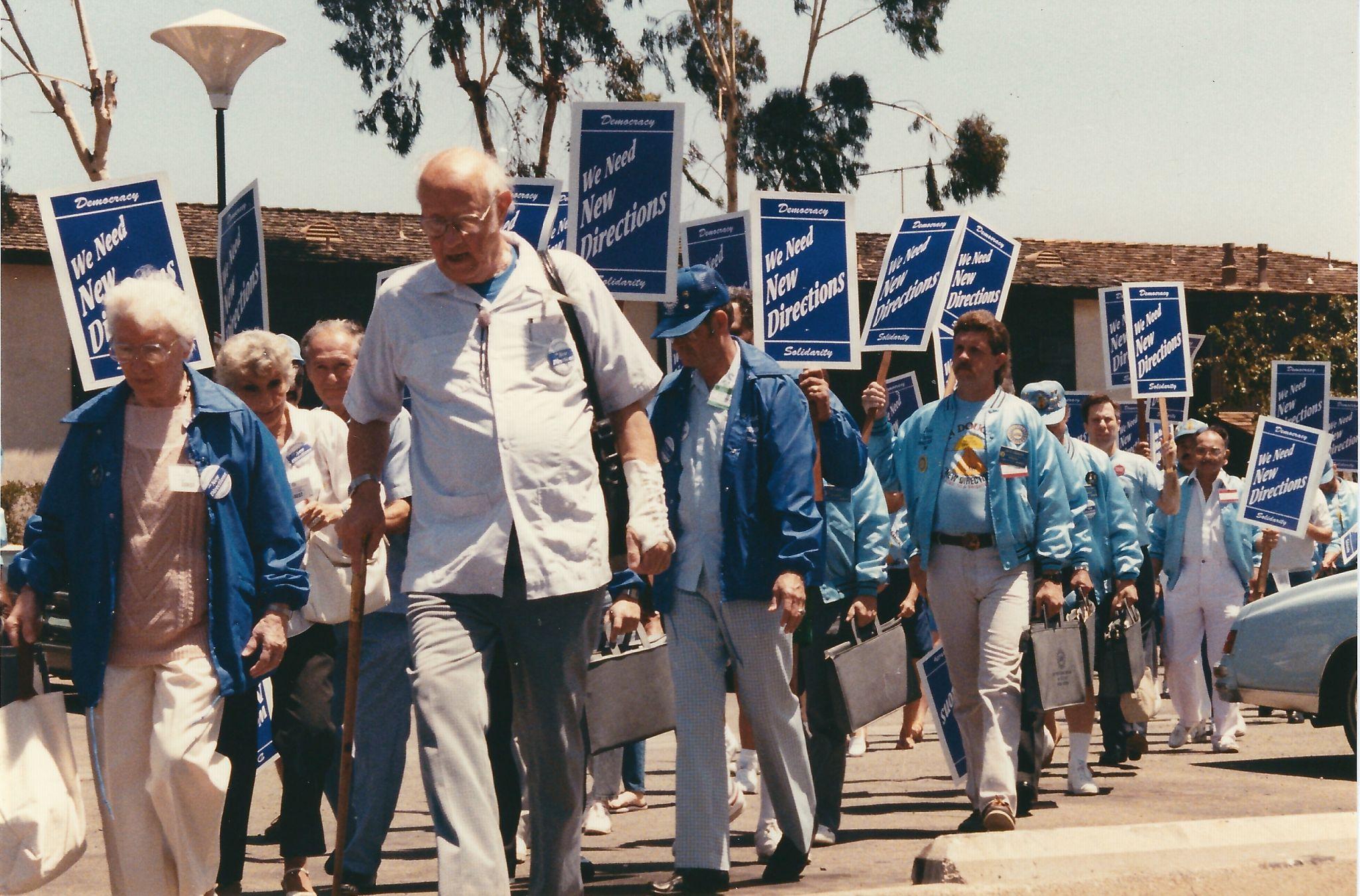

Left to Right, Sophie Reuther and Genora wearing their “New Directions” buttons, seated with Victor Reuther at a New Directions meeting.
In 1994 Genora was inducted into the Michigan Women’s Hall of Fame, which noted that in 1952 she “…was a candidate of the Socialist Workers Party for U.S. Senate from Michigan. At the age of 81 she is proud to say she still adheres to these ideas, principles and morals she espoused in her youth.” Isn’t it time that Genora Johnson Dollinger was inducted into the UAW’s “Hall of Fame?”
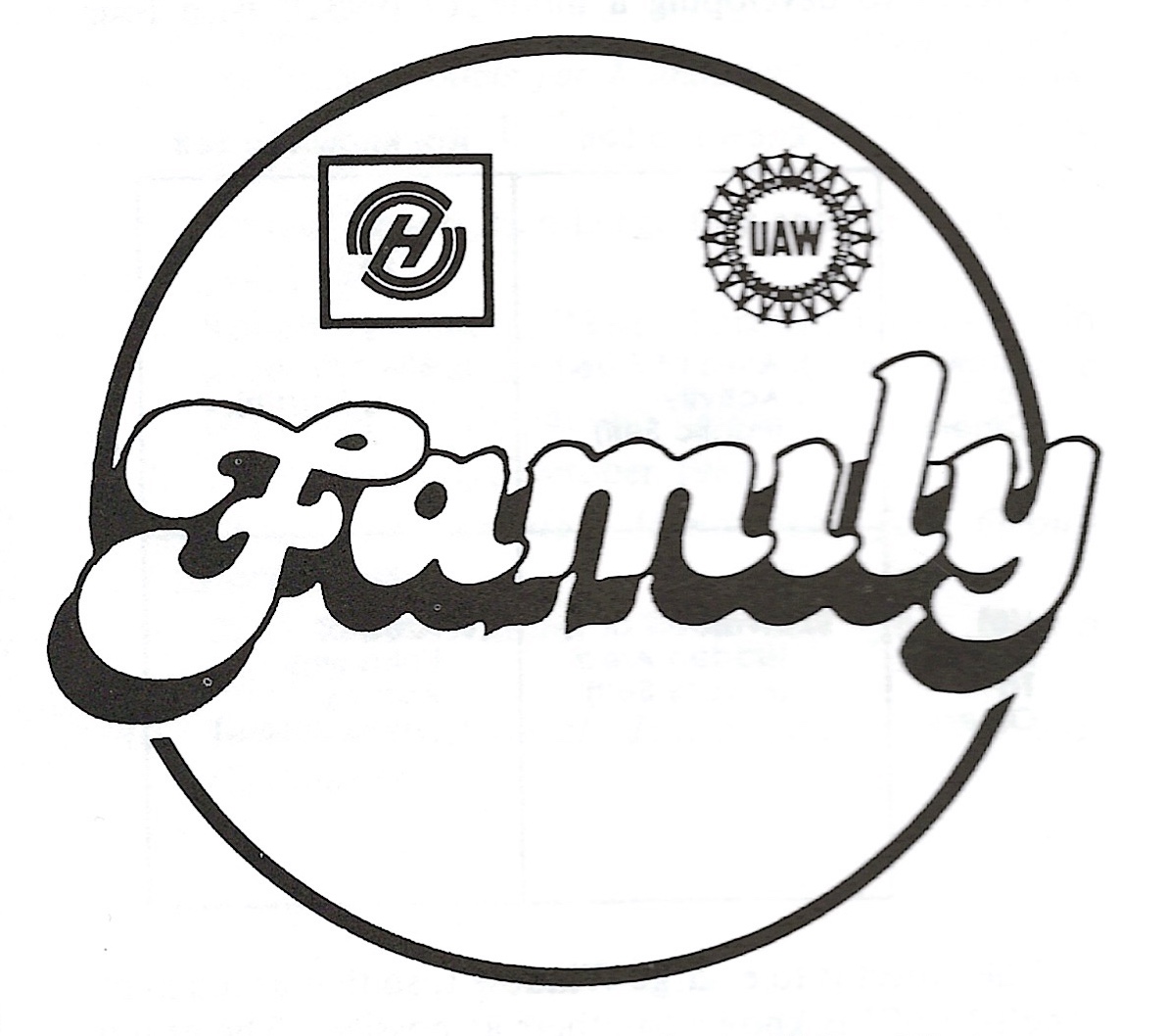
Postscript: GM’s Road to “Jointness”
The general conversation among reformers in the UAW centers on when the UAW transitioned from “bread and butter unionism” to “partnership-” or, as Genora would have it, “tuxedo-unionism.” That change in the leadership’s orientation became apparent on the factory floor with the startup of the “Quality of Worklife” circles and Joint Programs during the early and mid 1980s.
A careful reading of Sister Genora’s protest — that she traveled 2,000 miles to deliver — shows that the transition was actually earlier, in the 1970s, undercover. She told the Detroit News that she wouldn’t take part in a celebration of the Flint workers’ victory with GM in the room — especially since GM had recently reopened plants “in the South with non-union labor.”
If General Motors was looking ahead to cultivating the spirit of “jointness,” this was a peculiar way to go about it. Or was it? The reporter goes on to explain, “[Genora’s] reference was to last fall’s negotiations [1976] between the union and GM which resulted in the union demanding and getting assurances from GM that it would remain neutral in representation elections at GM plants in the South. The union won one subsequent election.”
The reporter, Jack Crellin, describes “Mrs. Dollinger” as “acidly questioning why union officials like Woodcock and Bluestone needed ‘GM’s seal of approval on organizing drives.’”
Crellin doesn’t report on what the UAW might have given up in return. An article in the Washington Post two years later — headlined GM Agrees to Let UAW Organize Plants in South — finally does. Reporting on “private” negotiations during Sept. 1978, the Post reported:
In an apparent effort to head off an explosive confrontation with the United Auto Workers, General Motors Corp. yesterday invited the union to organize its new plants in the South and Southwest. The action ended more than a month of private negotiations between the company and the union over GM’s so-called "Southern Strategy" against the unionization of its new plants.
GM President Elliott M. Estes said in a statement…that the company is adopting a ‘new hiring procedure’ that would give preference at its new plants to current union employees…Estes said the company would have no objection to the UAW becoming the bargaining representative at any of its new plants.
The UAW immediately hailed the GM announcement as a major victory…Union sources said yesterday that [UAW President Doug Fraser] was ‘walking on cloud nine’ as a result of the GM announcement.
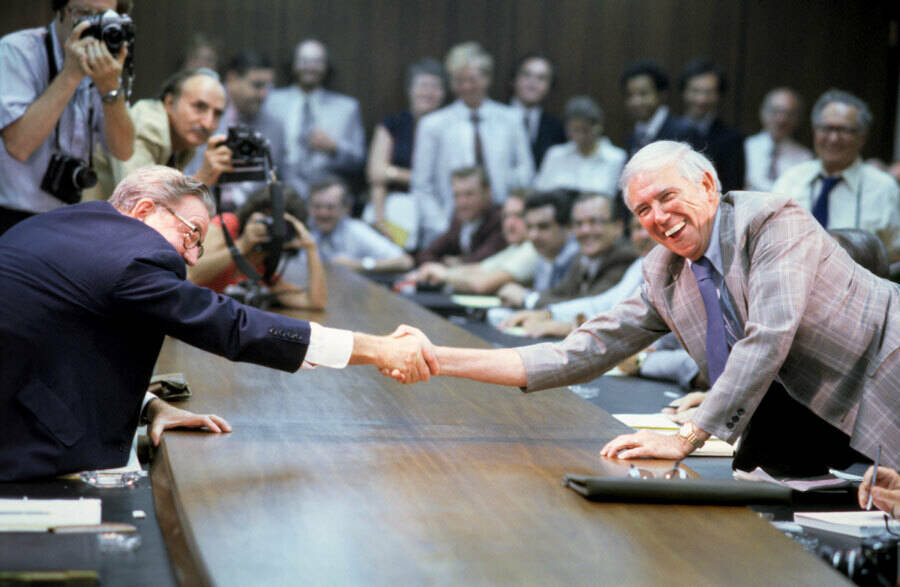
UAW President Doug Fraser kicks-off contract negotiations with GM in 1979. (photo: In These Times).
The article adds:
In the GM announcement, however, Estes said that, in exchange for the new agreement, the company expected the union to take a "constructive approach" toward increased productivity at the new facilities. There was no further explanation of what specific trade-offs might be involved in the new agreement.
GM’s anti-UAW “Southern Strategy” in the 1970s is what leveraged the UAW into delivering on “partnership and jointness.” That’s what Genora decried, as quoted in the Detroit News:
In 1937, we (the UAW) broke from the American Federation of Labor auto union because of its fraternization and collaboration with the auto corporations. In only 40 years we witnessed a return to tuxedo unionism and the celebrating of our union history jointly with GM officials and agents.
In the recent corruption convictions of 12 UAW officials, we know what that led to.
Frank Hammer is a former President and Chairman of UAW Local 909, GM Powertrain, Warren, MI & retired UAW-GM Int’l Rep based in Detroit. He was a New Directions activist in UAW Region 1.
Where Black History Month intersects with the UAW Flint Sitdown Strike of 1936-37
An interview with J.D. Dotson, Buick Foundry Worker & “Rebel Rouser” (1982)
by Frank Hammer
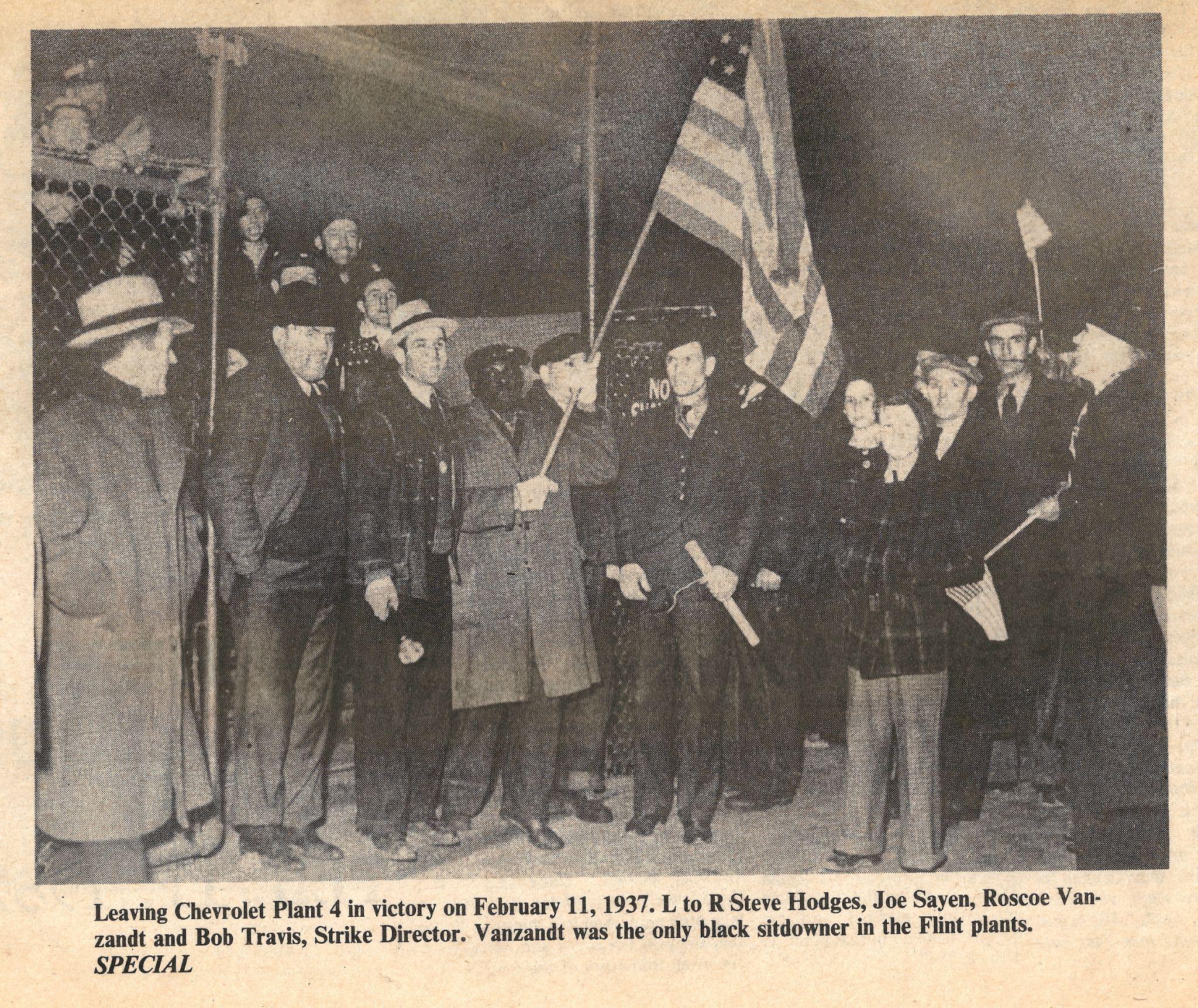
February 11, 2022 marks the 85th Anniversary of one of the most profound labor struggles in the US – the 44-day occupation of multiple GM factories by militant auto workers in Flint, Michigan. Referred to around the world as the Great Flint Sitdown Strike, it culminated in General Motors recognizing the United Auto Workers (UAW) as the sole bargaining agent at GM plants across the country, and agreeing to a first contract, which was all of one page.
The role that Black workers played in that strike is very rarely mentioned, if at all. There was Roscoe Van Zant, pictured above with some of the leaders of the successful occupation at Chevy Plant 4, the only Black worker who was actually part of the Sitdown. Martha Grevatt, retired Chrysler Tool & Die Maker and former Trustee of UAW Chrysler Local 869, told about him in The Occupy that won the union published in Workers World (Feb 13, 2012). She wrote:
One of the heroes inside Chevy 4 was Roscoe Van Zandt, an African-American worker. He stayed inside the plant from beginning to end. This was dangerous for a Black worker…At first, he kept to himself, but Socialists like Johnson and Howard Foster educated the white workers on the need for solidarity. There was one bed in the plant, and they gave it to Van Zandt.” A Sitdowner who knew him told Martha that he was “a natural leader.
Martha, who is a member of the Steering Committee of Unite All Workers for Democracy (UAWD), mentioned other African American workers:
GM was a Jim Crow operation then. In most plants Black workers were only employed as janitors. The exception was the Buick foundry, where conditions were the worst, and Black workers’ jobs were the worst of the worst. The Buick plant was not on strike, but was idled, and Henry Clark and Prince Combs, in whose homes the dimly-lit organizing meetings had occurred, built support for the union. J.D. Dotson was a Black Communist who carried messages from one picket line to another and in and out of the occupied plants.
I met J.D. Dotson in 1982 during one of the many Sitdowners’ “Pioneer Reunions,” held during the summer in Flushing Park in Flint. I would go up with other Detroit auto workers to be part of the wonderful picnics attended then by a couple of hundred Sitdowners and their families. Here’s my interview which appeared in the underground newsletter, Straight Talk published by rank and file members of UAW Local 909 at what was then the Chevrolet Motors plant in Warren, MI. We urged fellow workers to “read his remarks on the company’s tactics for keeping workers down and divided, and how the autoworkers overcame them.” He was memorialized many years later in this artist’s graphite drawing:
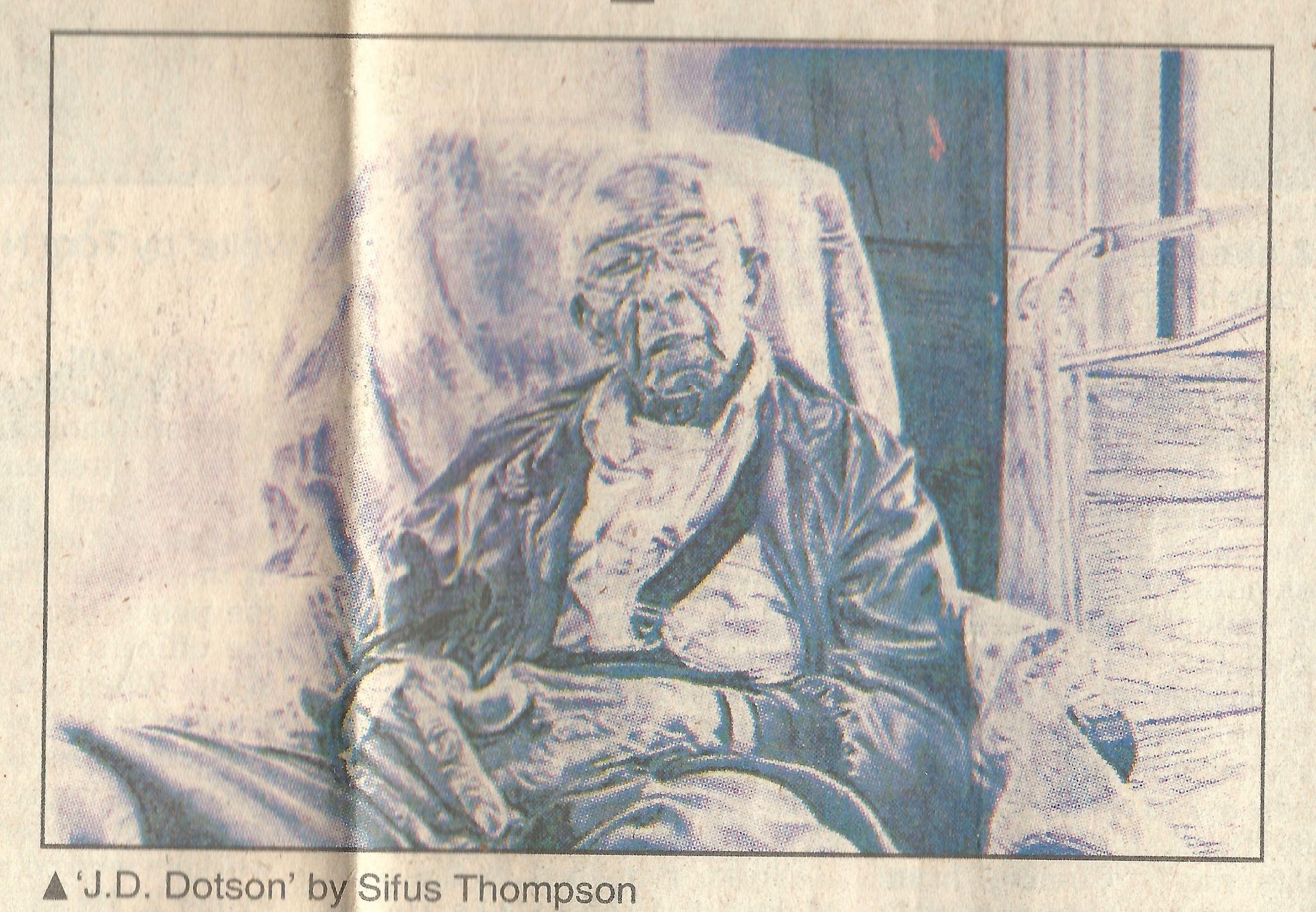
J.D. Dotson, in his own words
For years the Black man was kept out of work in the factory. The only time he worked was when the white man didn’t want to work. There was no union, so when the white man would stop work and strike, the boss would go out and bring the Black man into the shop in box cars. They had cots and we would sleep, eat, and work right there in the shop. When the whites got hungry, they would come back and we would be turned back into the street like we were sheep.
At Chevrolet the only thing a Black could get was a mop and a broom. At Buick we had some shake out job in the foundry that nobody did want.
You didn’t get water
You didn’t know from day to day whether you were going to work. When we did, we worked from six in the morning to six or seven in the evening.
You didn’t get water. They had one man who would come around with one of them old pint milk bottles, rinse it out and give you water. We could drink water with one hand, watch for the boss, and keep working with the other hand. You had to eat right on the job with dust, oil and everything in the foundry. You didn’t wash your hands because if you did, you didn’t have a job. This was not one day – this was everyday.
I remember a white man who was made superintendent and then he hired his brother. They would go around with old gloves and get them real dirty and nasty. If you said you needed a pair of gloves and your gloves were no good, he would give you a pair of the gloves he carried around with him. If you said you wanted a clean pair he would fire you. Some days you could take a toothpick and push it through the blisters on your hands – it would be so hot while you were trying to work.
We hid in basements
John L Lewis told us as long as the boss could keep white and Black separated, they were going to use both of us. He said the only way we could get anywhere is to get organized. There should be no discrimination. The Black man wouldn’t be offended by the white man because he knew he wouldn’t get anywhere without him.
In 1929 we started to organize in secret – five Blacks and two whites. We would go from place to place in open cars in zero weather to get a union started. We hid in basements. We couldn’t let nobody know what was going on, or they would go back in the shop and tell the boss.
We were called “reds, commies” and were called “goons.” The big manufacturer owners called us this. If you were weak minded they would tell you, “don’t have anything to do with that man because he’s a “goon.” Anytime you were a labor leader and fighting to get the union started they would call you a “goon” or a “rebel rouser.” They couldn’t put us any lower, even though a lot of people didn’t know what the meaning of a “goon” was.
We started under the AFL [American Federation of Labor]. Later on we got two unions in the shop, the AFof L and the CIO [Congress of Industrial Organizations]. We held an election to see which one we would use for our bargainers, and we accepted the CIO.
The AFof L, you see, was all white, and for years was skilled trades. The Black man couldn’t get into the unions until we brung in the CIO. The only way we got anything was when the union came into existence. That’s when we came into power.”
You won’t find any information on the UAW’s website or facebook page about J.D. Dotson. He was a member of the Communist Party, USA, as were many of the other leaders of the Flint Sitdown strike. Their history fell victim to the MCarthy-era witch hunts in the 1950s and a whitewashing of our UAW history by the Administration (Reuther) Caucus.* It’s time J.D. Dotson and the others – men and women – were placed in a position of honor for having risked their lives for the UAW.
PS — The notice below appeared on the UAW’s facebook page one day before “White Shirt Day,” as it came to be called. It’s flawed – 3 or 4 plants were occupied, not just one. Women didn’t work in GM factories then, but women from other factories along with the Sitdowners’ wives and girlfriends did play an outsized role as part of the Women’s Emergency Brigade.
Tomorrow UAW members celebrate White Shirt Day, honoring the workers who participated in the Flint Sit-Down Strike of 1936 and 1937 In the face of anti-union sentiment, brutal working conditions, and low wages, men and women working for General Motors came together to orchestrate a historic sit-in, where they occupied the Flint factory and demanded a seat at the bargaining table with GM, and won that right.
We will be sharing links tomorrow from UAW Region 1D, to join in the celebration. Remember to wear your White Shirts as well.
Autoworker Caravan solidarity with NYU grad workers
Autoworker Caravan stands in solidarity with our UAW siblings at New York University (NYU) who are on strike for livable wages and fair working conditions. It is inconceivable for the administration to keep the workers, who make NYU such a great university, in poverty level conditions. Graduate workers have become the lifeblood of the school. NYU cannot function without the hard work and dedication of the members of GSOC-UAW Local 2110.
In addition to a living wage major demands revolve around affordable healthcare and paid sick leave. How can NYU neglect this demand during the current healthcare crisis?
Autoworker Caravan is a network of rank and file UAW members who formed during the Auto Bankruptcy hearings. Our members went to Washington DC to make sure that the voices of workers were heard during that crisis.
We are raising our voices again in solidarity with our UAW siblings,
Autoworker Caravan
UAW worker solidarity with Alabama Amazon workers voting on union representation
As active and retired autoworkers and other workers covered by UAW contracts, we want to express our solidarity with your democratic right to vote for RWDSU representation at your Amazon workplace in Bessemer, Alabama. We have read about the ceaseless propaganda tactics your employer is using to scare you into continuing with the precarious conditions that maximize profitability and undermine your health and safety.
We realize that your struggle for union representation can be an important tool in your fight for decent working conditions, wages and benefits. We also realize your decision will have implications not only for Amazon workers in other locations, but for other workers in Alabama.
Your victory will help our union and other unions to start winning elections at Southern auto plants and in other industries as they see your method of organizing yourselves and your community as a positive model.
Know that workers around the country—indeed around the world—are watching your struggle and reach out to you with our hands and our hearts!
Here is a solidarity statement from an active UAW reform movement member:
As a worker, you’ll always have your wages, benefits and working conditions in a union or non-union shop. The only difference is having a voice on those important issues. Most workplaces are run like a dictatorship. Having a union brings democracy and a voice to the workers. A seat at the bargaining table. Nothing is perfect in this world, but as workers, we fight for what we need when we stand together United.
Autoworkers Caravan (AWC)
Solidarity with Brazilian Ford workers against plants closings and layoffs
Read the Auto Worker Caravan statement.
Don’t let auto plants become Covid-19 super spreaders
Read the Auto Worker Caravan press release.
Petition: We Need Safe Plants
We demand that FCA, GM, Ford and Independent Parts Suppliers keep all plants closed until they are prepared to regularly test and provide N95 respirators.
We also demand slower line speed to allow for greater distancing, paid cleanup time for disinfecting work stations and more hand washing stations on the line.
Sign here
Auto Worker Caravan Lima Ford Press Release
This Auto Worker Caravan press release presents some UAW Local 1219, Lima, Ohio Ford Engine Plant African-American workers’ own written statements about a particular racist incident and its broader significance.